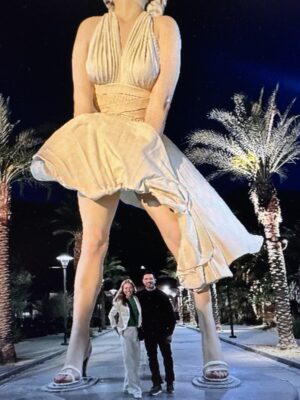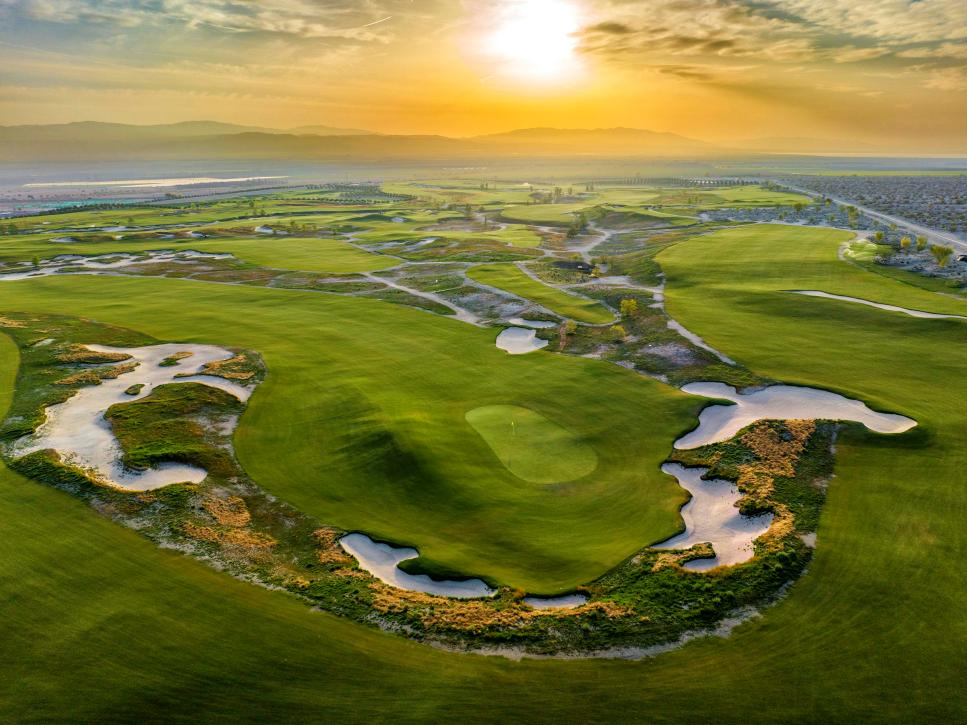It’s a New Year in Tennis Paradise in the Coachella Valley!
|
||||
|
|
|
||||
|
|



On today's episode, Kelly and Mark talk about their love of Palm Springs, their visit last week, the friendliness of the people, the sunshine, the citrus, the restaurants, and everything they love about the Coachella Valley!
FOR IMMEDIATE RELEASE
INTRODUCING A NEW LIFESTYLE AND REAL ESTATE TV SHOW
Featuring the most influential voices in real estate
Sheri Dettman - Lifestyle Realtor/TV Host
Featuring
Palm Springs, La Quinta, Palm Desert, Rancho Mirage, Indian Wells, Indio, Cathedral City, and Thermal

The American Dream TV proudly announces the release of its newest show set to captivate audiences nationwide. The Emmy-nominated TV show, celebrated for its compelling blend of lifestyle and real estate narratives, airs on national platforms such as The Travel Channel and prominent streaming services including Amazon Prime, YouTube Movies & TV, Tubi, Amazon Fire, Apple TV, and Roku. With a substantial social media presence and commanding visibility on leading streaming platforms, The American Dream TV solidifies its expansive reach and profound influence.
The American Dream TV, together with its production team, has garnered acclaim including an Emmy nomination, Telly Awards, and Viddy Awards, along with national recognition for showcasing authentic stories of neighborhoods and featuring top real estate professionals. Each episode spotlights elite realtors and mortgage lenders chosen for their expertise, reputation, and recognition from both peers and clients.
Executive show producer Craig Sewing, Inman News Nominee for "Most Influential in Real Estate," carefully selects the best hosts to represent the voice of lifestyle and real estate in each market. The show can be watched on a variety of networks and boasts millions of views on social media, proudly embracing its identity as “positive media” specializing in real estate, lifestyle, and culture.
About The American Dream TV:
American Dream Media and Tech is a dynamic media company delivering premium content and innovative technology solutions. The American Dream TV, an Emmy-nominated national TV show centered around real estate and lifestyle, inspires and enriches communities across the country through positive media. Featuring over 1,000 top-producing real estate professionals as the authentic voice of their markets, the show airs on major networks and streaming platforms, amassing millions of views.
Connect with us: americandreamnetwork.tv
On social: @theamericandreamtv
As Seen On

THEIR HAPPY PLACE Azoff and Cue at Ladera Golf Club in Thermal, Calif. Photographs by Channing Benjamin

CREATIVE JUICE The genius of Cue, Azoff and Hanse combined to transform a lemon grove into holes like the par-4 13th.


There has been significant media coverage of a recent legal settlement regarding the real estate industry. Last week the National Association of Realtors® entered into a settlement agreement in the Sitzer-Burnett case, agreeing to pay a $418 million fine. We’d like to clarify what this means for home buyers and sellers.
First, note that the settlement is pending approval by the courts, and if approved, won’t go into effect until mid-July. Thus, it has no immediate impact. If it goes into effect, buyers and sellers will see brokerages and agents adopting new policies nationwide.
Since the 90’s, seller’s agents have shared their commissions with buyer’s agents. This settlement will, in short, encourage buyers to pay for - and negotiate - compensation with their agents. Here’s how this will likely affect buyers and sellers:
SELLERS
BUYERS
Buyer compensation has historically been folded into the purchase price; as these changes go into effect, it remains to be seen how payment will be applied. Furthermore, it is unknown if and how these changes will impact home prices, particularly given the historically low supply and high demand in our competitive market.
In sum, the major news headlines and stories, from the New York Times, to CNN, have misrepresented and inaccurately reported this story. While change is inevitable in any industry, we are confident that you, our clients, understand and value our work, and we will continue to go above and beyond to exceed your expectations.

Published on 2/15/2024 at 12:52 PM
TUCKED AWAY ALONG THE EDGE OF A COUNTY FAIR IN INDIO, CALIFORNIA, is a curious building with distinct Middle Eastern flair: white with blue trim, covered in murals, and topped with a bulbous gold Persian dome and pointed arches that court the Southern California breeze. While elsewhere on the grounds neon-lit Ferris wheels spin against the night sky, demolition derbies smash large vehicles and musical acts like Smash Mouth smash eardrums, inside this building are wrinkly and glistening fruit, a virtual embarrassment of chewy caramel riches. Abbadas, Medjoosl, Barhis, Brunettes, you name it. Halawi, Hellali, Honey, sure, those too.
This is the Taj Mahal building, a remnant from when the Riverside County Fair & National Date Festival was a tribute to the Coachella Valley cash crop of dates, and its Middle Eastern origins. Though today the Coachella Valley may be best known for its blowout music festival, in the early 1900s, thanks to some intrepid scientists and the imagination of some truly Disney-level storytellers, it was the destination that dates built.
This iteration of the transportive fair was launched in 1947. On certain nights guests wearing Arabian Nights-style attire got in the fair for free, and the whole grounds resembled a movie set—camel races and all. A Baghdad stage designed by Hollywood art director Harry Oliver hosted sequined nightly performances of “One Thousand and One Nights.”

The overt appropriation has dwindled, but in its 76th year, the heritage remains in a few architectural elements and the National Date Festival’s Queen Scheherazade Pageant. A part of the fair from its beginnings, the pageant originated as a stepping stone to the glitzy Miss California title. Today it’s morphed into a scholarship fund, where women eschew swimsuits in favor of billowing harem pants, vying for up to $3,500 in prizes.
And the dates remain. Today, the Coachella Valley is still the number one producer of dates in the US, shipping off 90% of the country’s crop. Throughout the valley, date palms dangle fruit in clusters like grapes. And yet, dates aren’t native to the United States, let alone California. So how did the flowering plant come to headline a regionally beloved festival and serve as a magnet for local tourism?
Enter the agricultural explorers.

A little over a century ago, American cuisine was heavy on meat, cheese, and potatoes. The country’s agricultural yields had little in the way of fruits and vegetables, and many were seeking some palette diversity (not to mention fiber). In an effort to diversify American crops and diets, in 1898 the USDA formed an elite task force of plant scientists. These “agricultural explorers” would trek around the world Indiana Jones-style, culling plants and bringing them back home to the States. They introduced tens of thousands of foods we still eat today, including: mangoes, avocados, horseradish, kale, nectarines, papaya, pistachios, and, of course, the date palm, native of the Middle East and North Africa.
The program came on the heels of the 1893 Chicago World’s Fair, where Greater Los Angeles was coincidentally introduced as a place of fertility, abundance, and all things tropical. A couple decades earlier, the Southern Pacific Railroad laid tracks throughout the desert as a result of westward expansion, but the discovery of nutrient-rich soil and a massive desert aquifer stretching from the San Jacinto Mountains to the Salton Sea lead to another gold rush of sorts for parcels of the region’s farmland.
The USDA’s agricultural explorers noted that the soil conditions in Algeria, its neighbors, and the Arabian Peninsula were similar to that of the Coachella Valley, which some referred to as the American Sahara. And there, the date palm, one of the oldest domesticated crops, were abundant. Plus, the palm’s fruit was desirable—sweet, delicious, and rich in vitamins and minerals helpful for relieving common ailments like constipation. The quest to import date palms to the States began romantically: A botanist named David Fairchild went to Baghdad to investigate the species, in part because he remembered its role in A Thousand and One Arabian Nights. His fellow USDA scientist Walter Swingle followed, lugging a clutch of large, unwieldy, 60-pound tree offshoots back to the Coachella Valley (they had to be offshoots, as seeds could create anomalies in the DNA). Once planted, the trees thrived.

Curving through the Palm Desert, the Southern Pacific Railroad, and eventually Highway 111, allowed tourists to travel to foreign lands without leaving the country. At the turn of the century, the acres of date palm farms provided an escape to what at the time was viewed as exotic—an admittedly problematic perspective popular culture was all too happy to support.
Fueling it was an Americans obsession with a romanticized idea of the Middle East, as studios pumped out movies like Cleopatra, The Queen of Sheba, and The Sheik, starring a very un-Middle Eastern Rudolph Valentino. Not only were films affected by the craze, but architecture, fashion, art, and agriculture. Landscapes were fashioned accordingly: The towns of Coachella Valley went all in, designing attractions to mirror Hollywood sets and opening date shops shaped like pyramids and Bedouin tents. The town of Walters changed its name to Mecca in 1904, while elsewhere, there were name makeovers like Cairo Avenue, still in use today. There were even (thankfully abandoned) plans to create an entire town called Arabia, with architecture reminiscent of the Sahara and a shopping complex where customers would arrive on camels.
And in 1921—the same year as The Sheik’s big screen debut—the town of Indio launched the International Festival of Dates to a backdrop of masquerading harem girls, camel races, and elaborate Arabian costumes. All “The Wise Men” were going, said the promotional pamphlets.
Sometime after the second World War, the Date Festival merged with the Riverside County Fair. And as geopolitics and America’s perceptions of the Middle East shifted in the subsequent decades, the societal obsession with Middle Eastern stereotypes dwindled. The dates, it seemed, were the era’s few survivors.

Stop by the farmers market in Indio on a typical Saturday and you might run into Tadros Tadros—“A man so nice you gotta say it twice,” says his son Mark—manning the Aziz Farms booth. Born in Egypt and armed with a degree in agriculture and horticulture from the University of Cairo, Tadros moved to the States in the 1960s in search of new opportunities. He was a beekeeper for a time, as well as an exceptional tennis player, and took a job as a tennis pro in the Coachella Valley. It was there that he first spotted California-grown Yellow Barhi dates.
“He was familiar with the more exotic [date] varieties like the Barhi,” says Mark. “But most growers were letting it cure to a brown state as opposed to selling it when it was still crunchy and yellow like an apple.” Seeing an opening, Tadros procured some Yellow Barhi, drove to Los Angeles, and sold them out of the trunk of his car to Egyptian expats. He eventually saved up enough money to buy some land and start his own operation. Today, Aziz Farms ships primarily within the United States.
“Detroit's really big for us,” says Mark. “Medjool dates are big there for folks like us, because we're kind of a small to mid-sized producer and will deal with a lot of the marketplaces where you'll see larger ethnic populations.”
“I've had friends that to this day think I’m a coconut farmer and I’m lying to them about what I grow on our trees.”
A few years ago, Mark took over the business, and had to reckon with the declining state of the industry. In Mark’s words, farms are a dying breed. But he has a few tricks up his sleeve to keep the farm alive, including diversifying his crops, planting vegetables and partnering with restaurants to meet their supply needs.
He’s also started hosting adult field trips. Based on the same curriculum as the school kids’ program, the grown-up offerings are geared towards spreading the word about proper growing practices and the financial impacts of agritourism.“If you look at some of our ethnic customer base, they're what I consider date experts, date aficionados: They understand dates at their core, they eat them differently, they use them differently, they cherish them differently, and they understand very specifically where these things come from,” Mark says. “But I don't think that the average American really understands the impact of the Coachella Valley. I've had friends that to this day think I’m a coconut farmer and I’m lying to them about what I grow on our trees.”

For those interested in learning more about the date’s renaissance in California, the Date Museum inside the Coachella Valley History Museum pays homage to the region’s agricultural transformation. But while you’re in the area, thick creamy date shakes are a must. Some would say it’s the unofficial drink of Palm Springs. And you’ll find an abundance of options. Stop by farms like Hadley’s Fruit Orchards, or even get a version at the Ace Hotel & Swim Club. But for the full date experience, take your date to Shield’s Date Garden. One of the oldest date farms in the country, just look for the kitschy gigantic knight armed with shield and sword, pointing to the showroom.
First opened on Christmas Day in 1924 by mining engineer Floyd Shields and his teacher wife Bess, two lovebirds looking to capitalize on the burgeoning date industry, romance was a part of the formula from the beginning. Tasked with deciding how to market his business, Shields looked at the Arabian Nights themes elsewhere and decided he would focus on matters of the heart—and the libido. Specifically, with a slideshow called the Romance & Sex Life of the Date. Today, you can screen the presentation in the shop’s Romance Room (or just stream it on the website).
The subject matter is more about the propagating fruit and the intricacies of date farming, but the insinuation is more than enough to draw curious passersby inside Shields’ agricultural castle. So while the National Date Festival’s date focus has admittedly dwindled over the years, swapping the centerpiece fruit for rides, livestock shows, and Smash Mouth, there’s still much to see. Try doubling up your next Southern California getaway—or your trip to Coachella Valley Music and Arts Festival—with a stop at the fruit-forward gem. Get the date shake, and if you’ve brought a date yourself, consider opting for two straws.
|
||||||||||||||||||||||||||||||||||||||||||||||||||||||||||||
Doug Ellin, creator and head writer of the huge HBO hit “Entourage,” is parting with his lovely La Quinta, CA, abode for exactly $3,995,000.
Nestled in the Coachella Valley and surrounded by the soaring Santa Rosa Mountains, this four-bedroom, 4.5-bath vacation getaway measures just over 4,100 square feet inside.
Ellin hasn’t had the home for long. He purchased it a year ago for $3,300,000, according to Realtor.com®.

(Realtor.com)

(Realtor.com)

(Realtor.com)

(Realtor.com)

(Realtor.com)

(Realtor.com)

(Realtor.com)
A recent renovation added premium appliances, custom cabinets, and gorgeous stone counters to the spacious kitchen. The open floor plan also includes a dining area and family room, which features a bar that’s perfect for hosting a real-life entourage. The main bedroom comes with a sitting area, remote-controlled blinds, and a spacious spa bath.
There’s a guest casita with a living room, kitchenette, and fireplace. Out back, there’s a covered patio, dining space, a pool, and a fire pit.
Most coveted of all, however, just might be the southern exposure, which offers views of the mountains, desert, lake, and the fancy Andalusia golf course, where this home is located.
“Entourage,” Ellin’s biggest hit, ran for eight seasons, ending in 2011. He also wrote and directed the 2015 movie “Entourage,” and he was a producer on the 2016 movie “Bad Santa 2.” Currently, Ellin is co-host of the “Victory” podcast.


LA QUINTA, CA — Construction on renovations to the Hideaway Golf Club was slated to begin in May after members voted to go ahead with a massive renovation this week, according to a recent news release.
Peek inside the video below to see what they have planned for the space for the exclusive club.
The plan includes refreshing the golf courses, including new greens, bunkers, transitional landscaping and updated irrigation.

Improvements to the clubhouse include a new spa and fitness center building, a new upstairs casual dining room, renovated formal dining areas, and more.
.jpg)
Still, more improvements will include expanded pickleball courts, two new tennis courts, and an indoor/outdoor dining area with bocce courts for league and family play.
Robert McDonald, President of Hideaway’s Board of Directors, described the voting process with members as successful.
“The overwhelming turnout and strong support is the culmination of three years of planning and scores of meetings with members," he said. "Throughout this process, the Board and our committees listened to what our 435 equity members wanted. We also heard their concerns and their needs through focus groups and surveys. Engagement was bolstered through the 65 club members who volunteered their time to review plans and give feedback. It is gratifying to see the membership come together in support of this significant plan.”